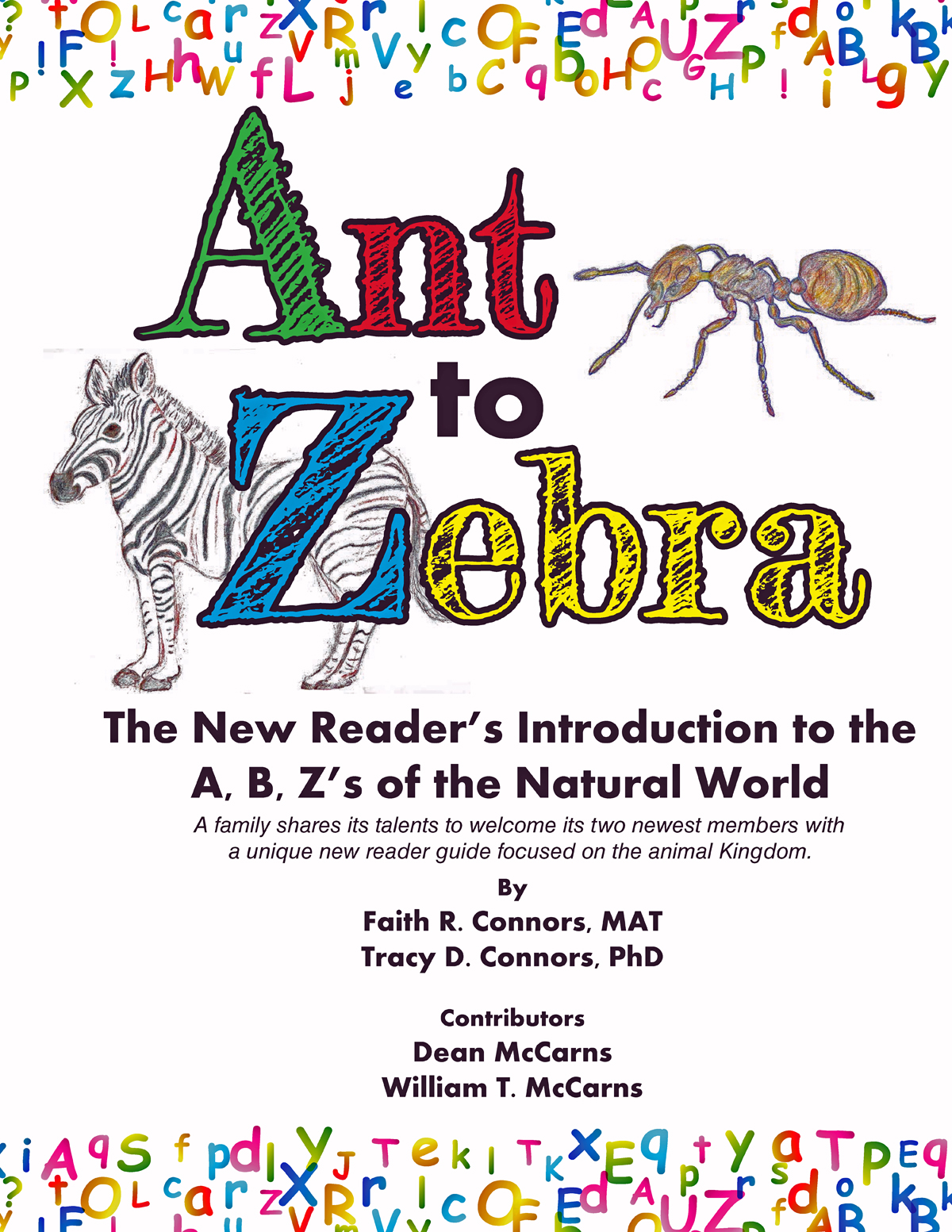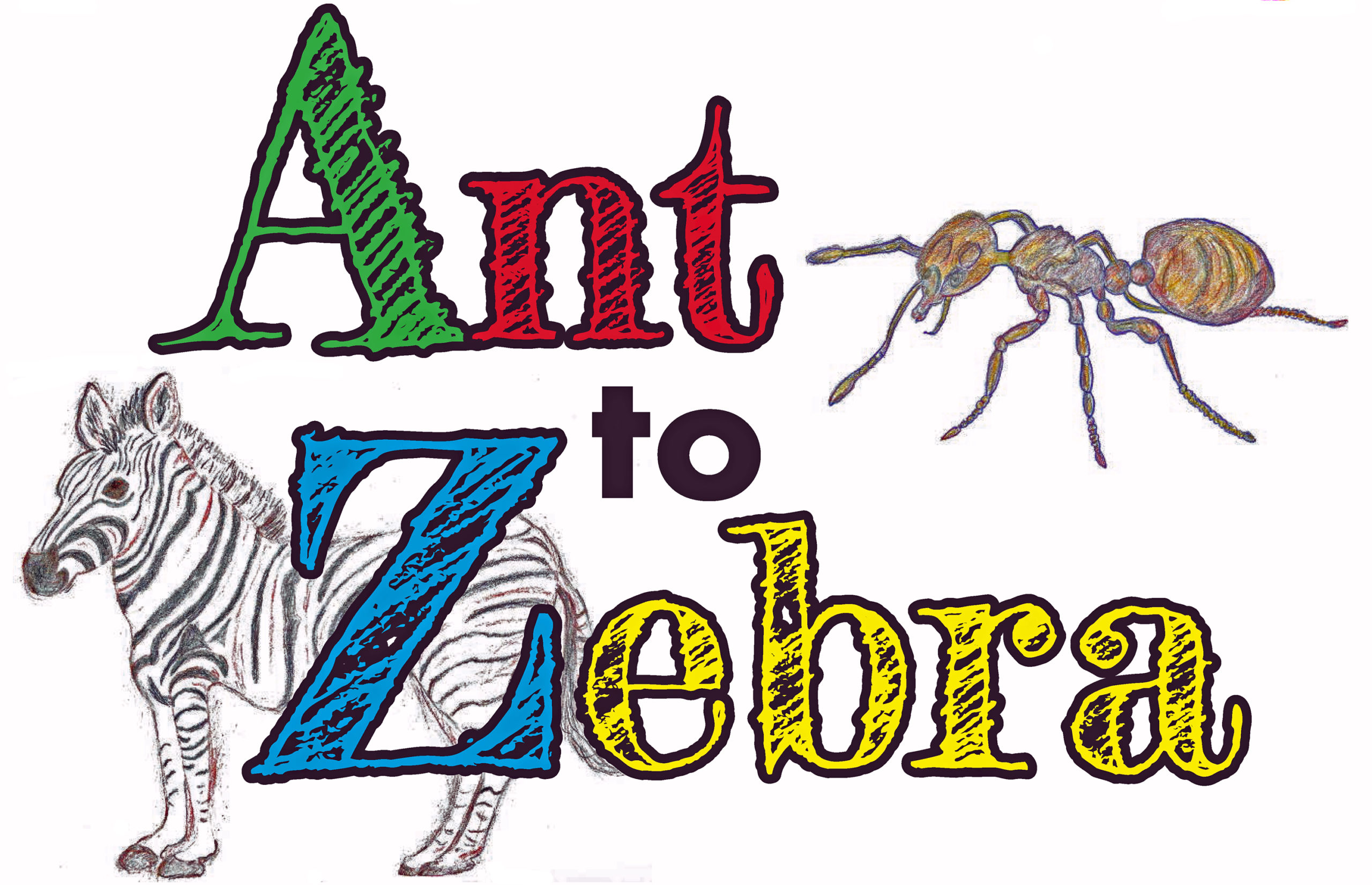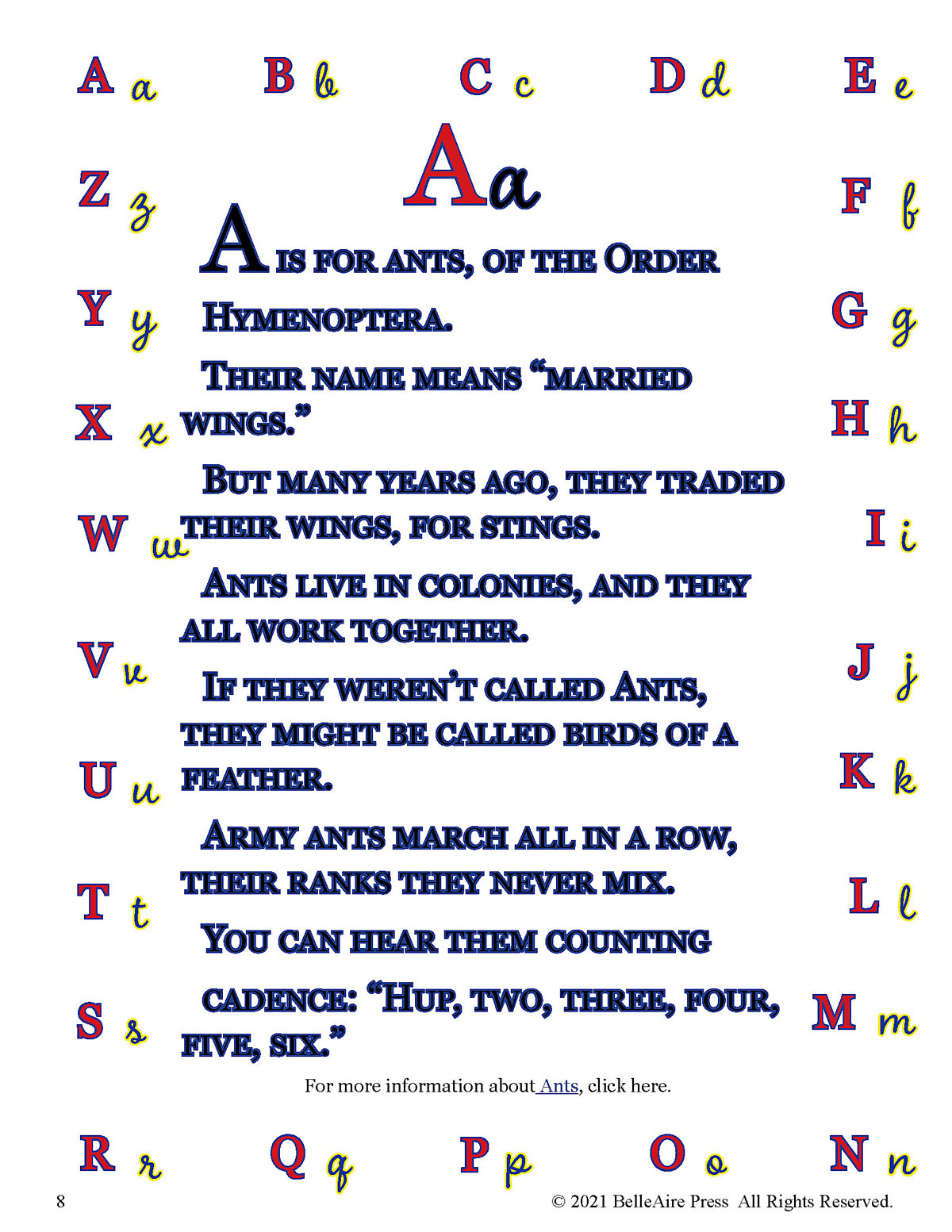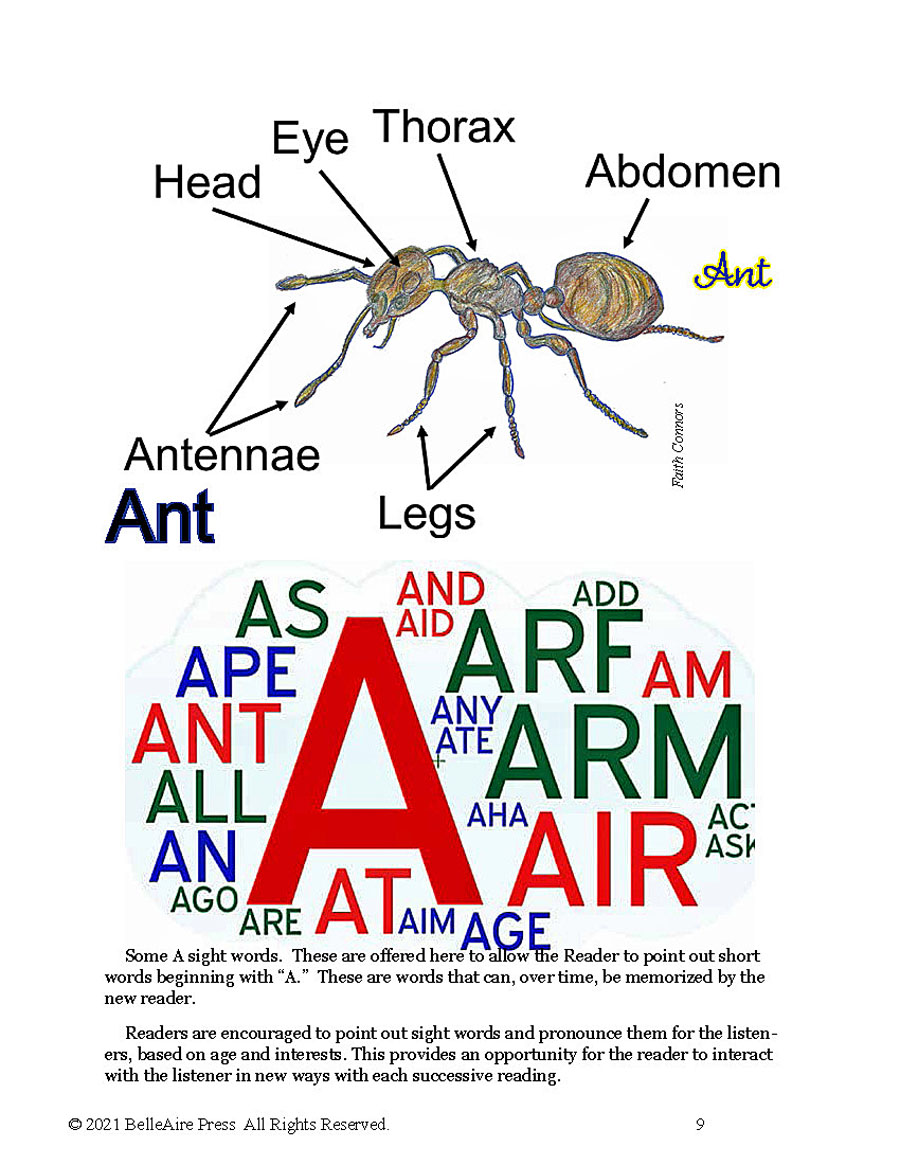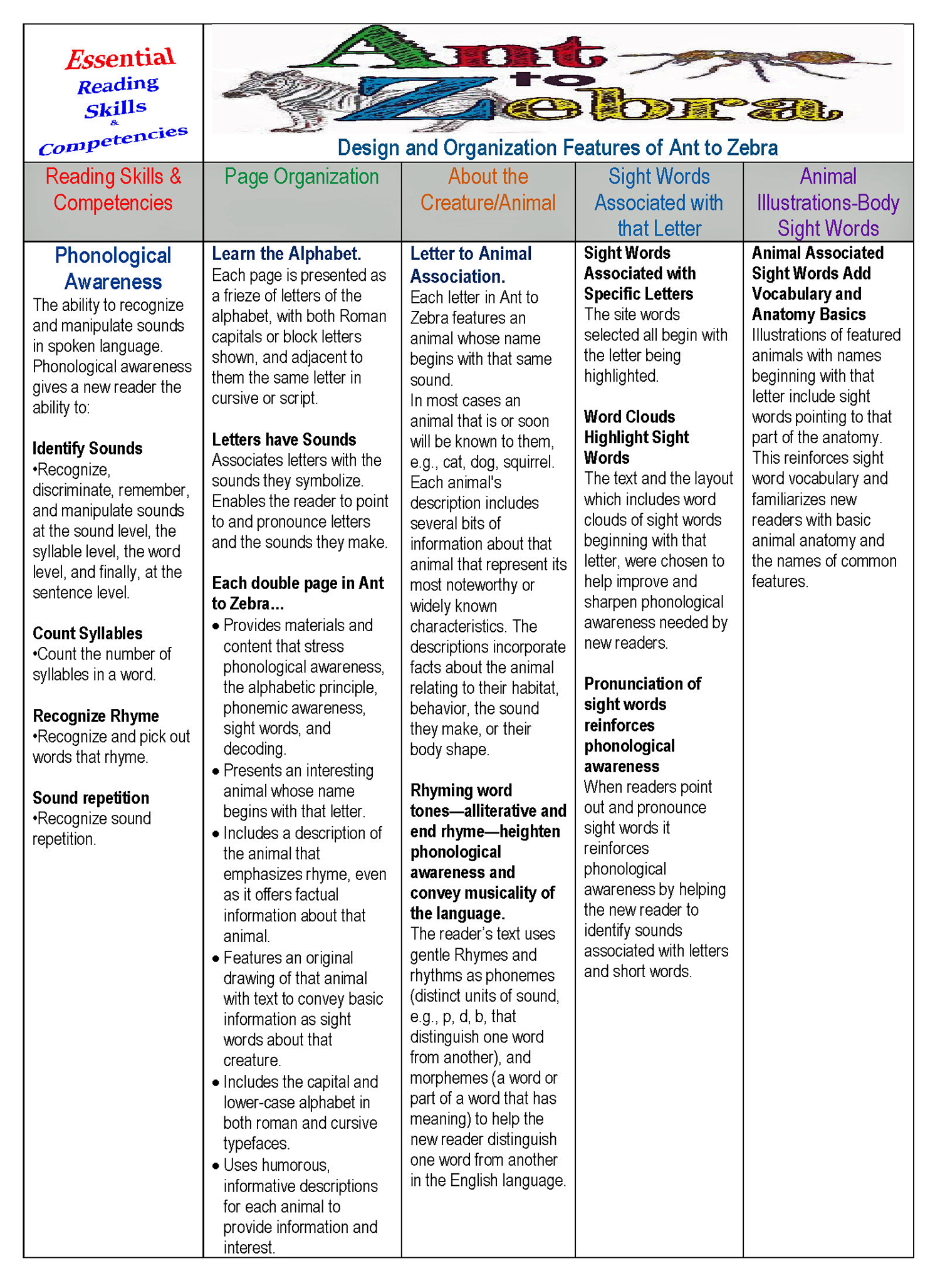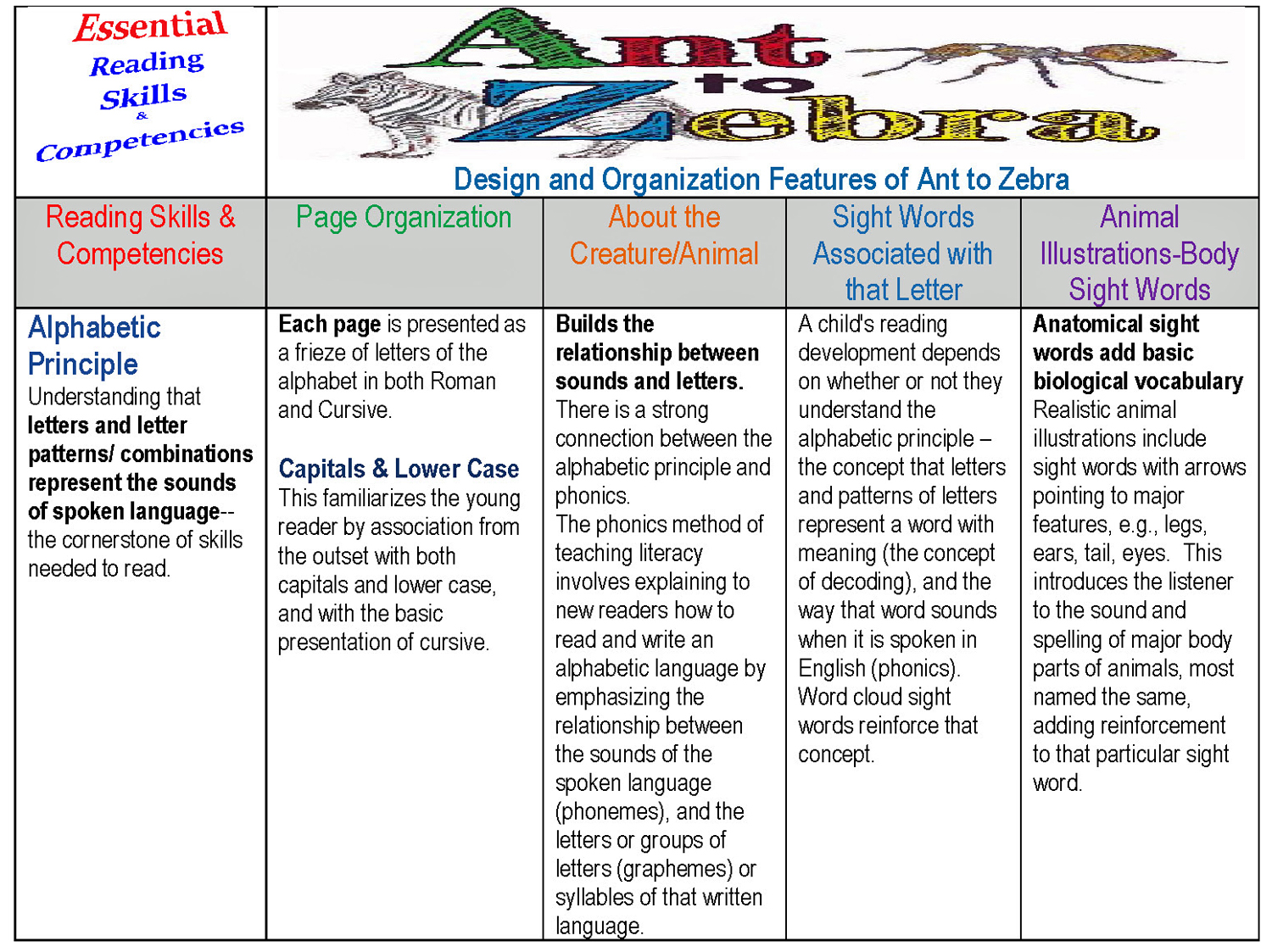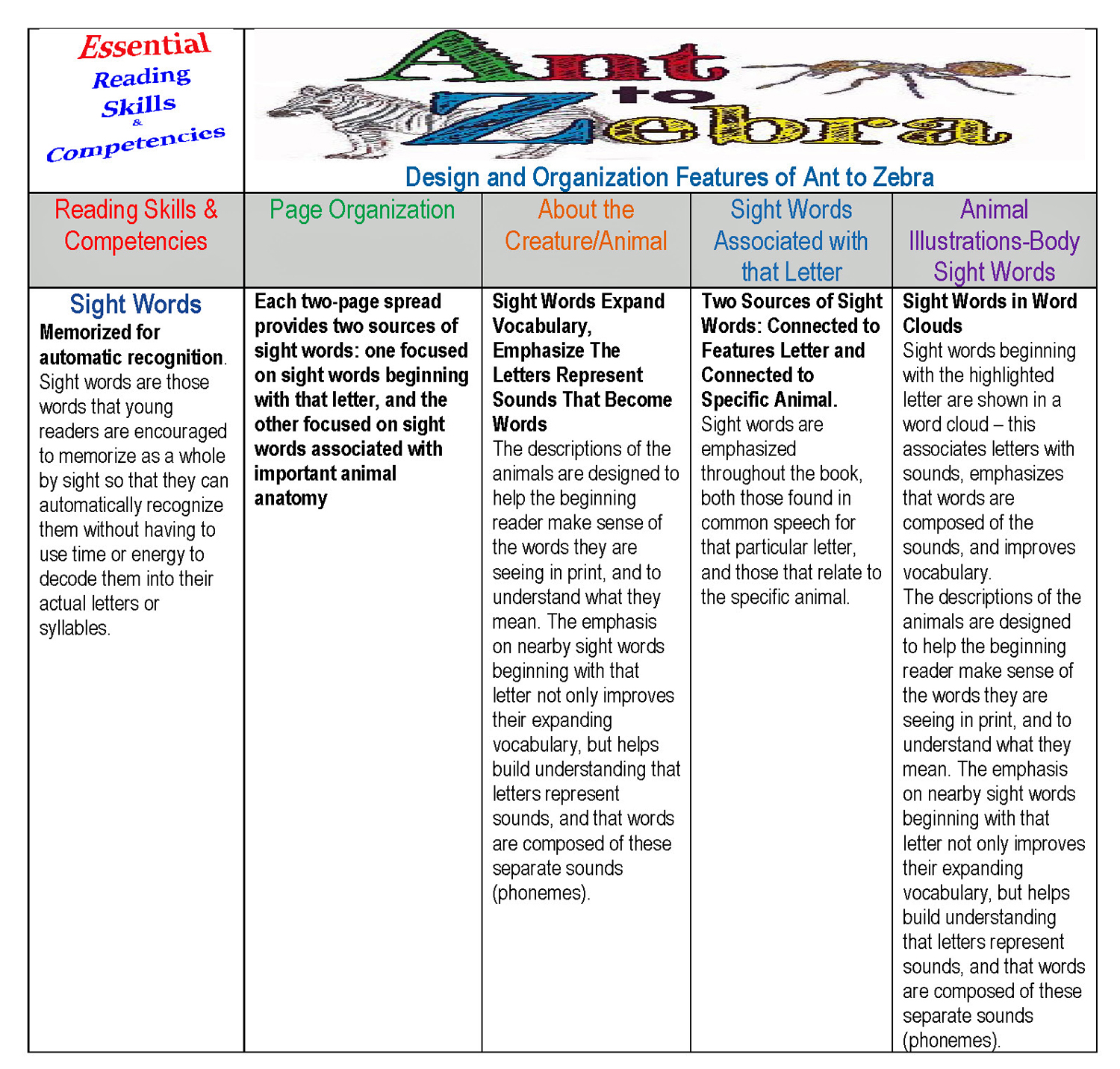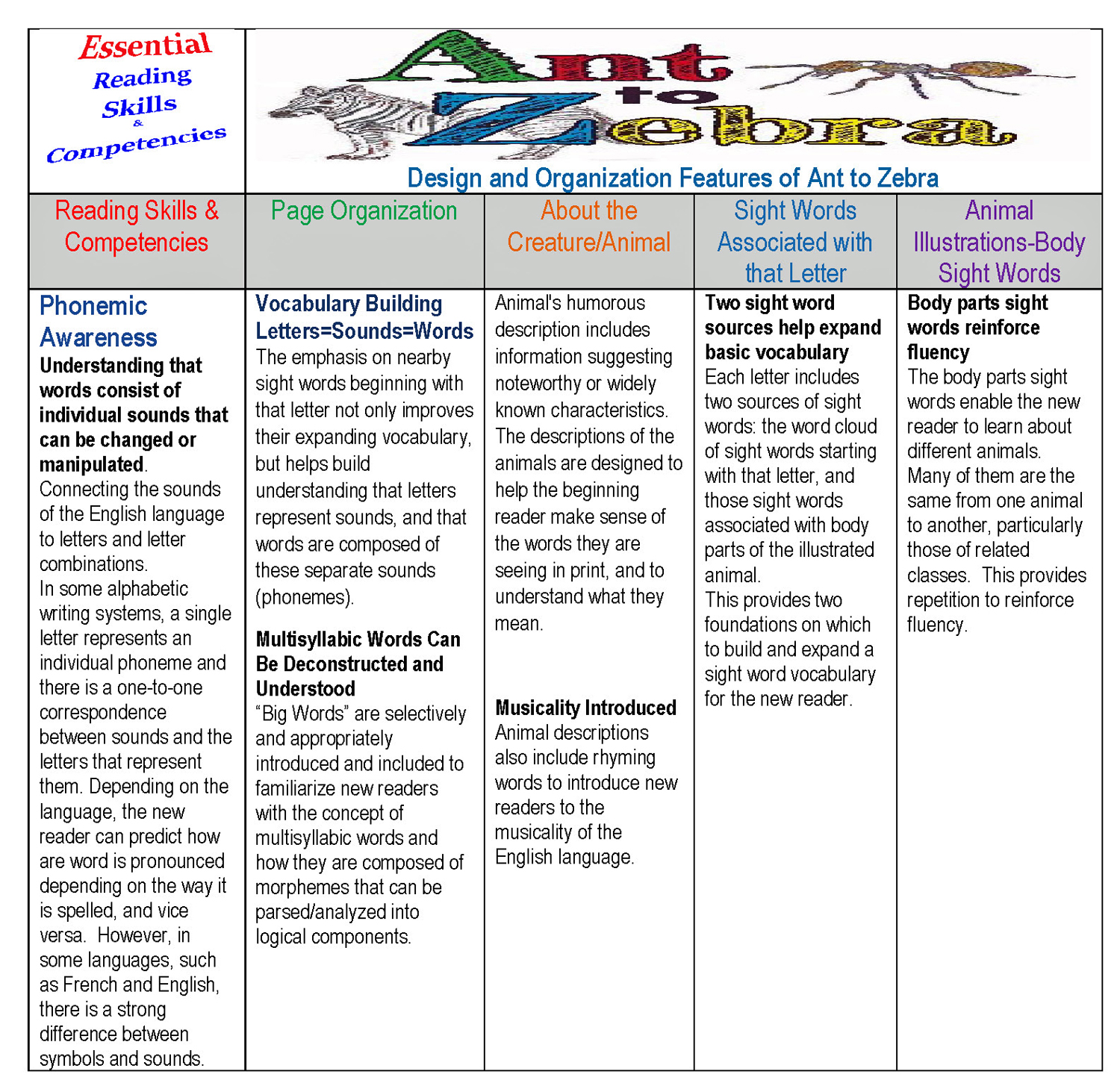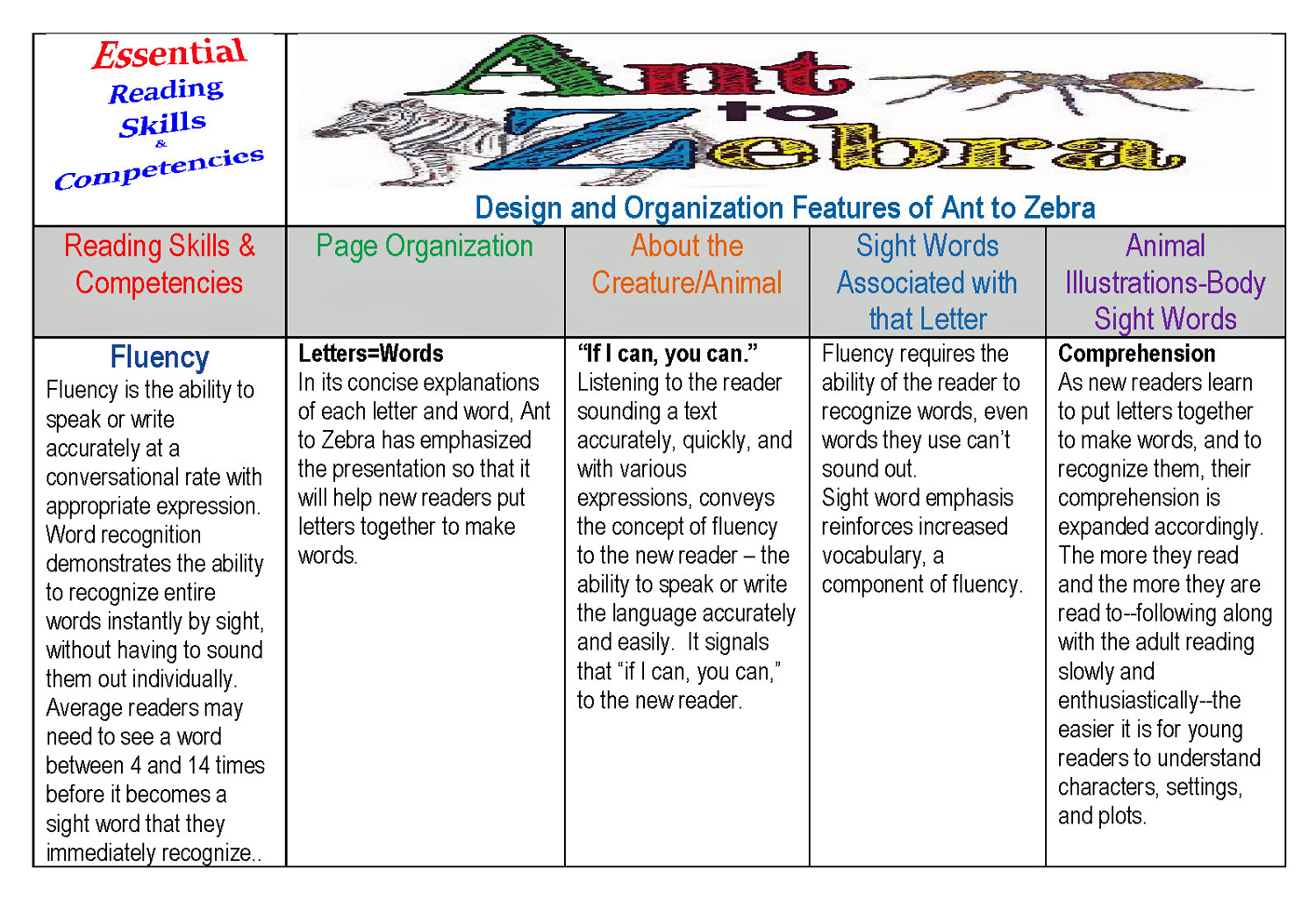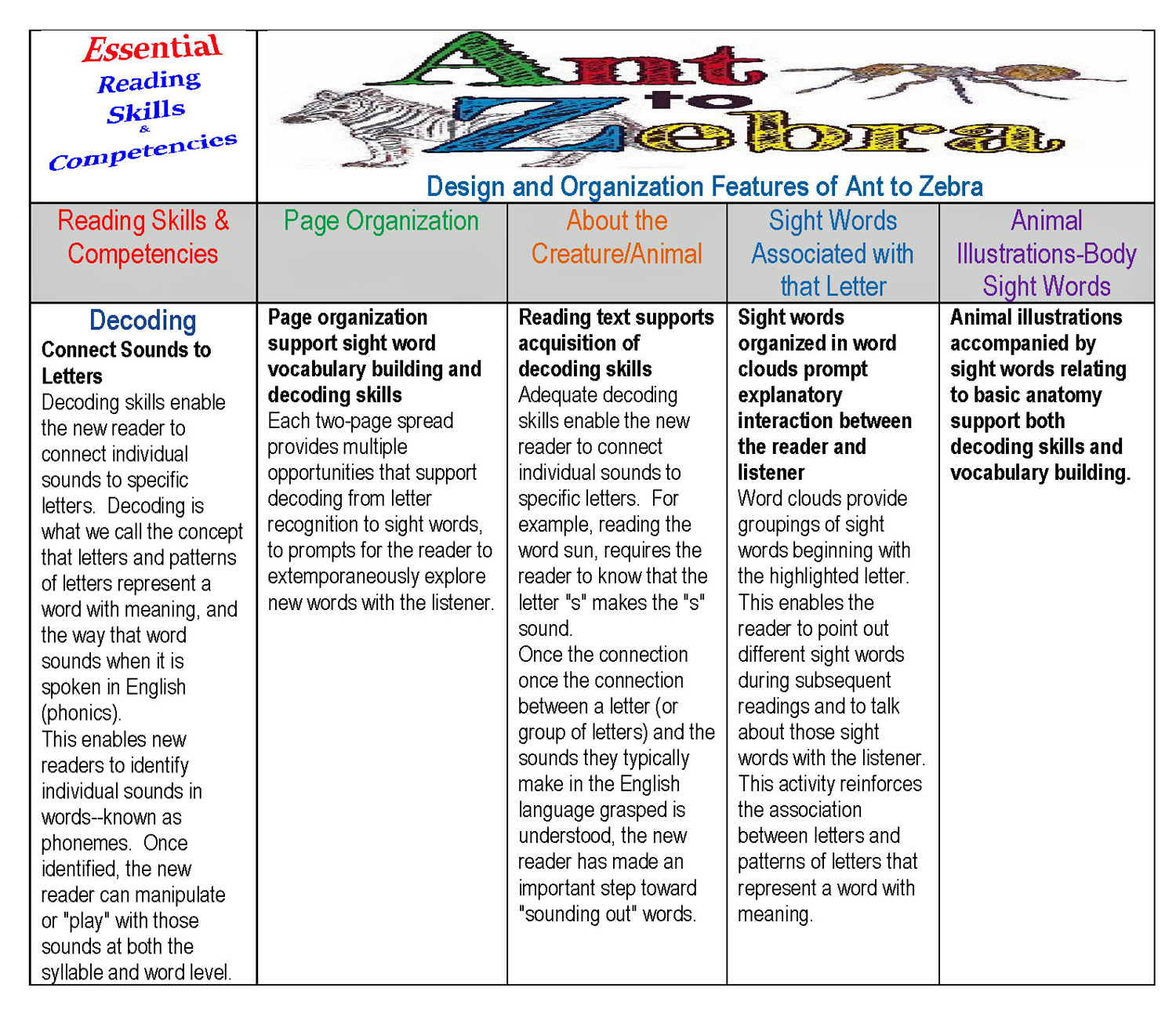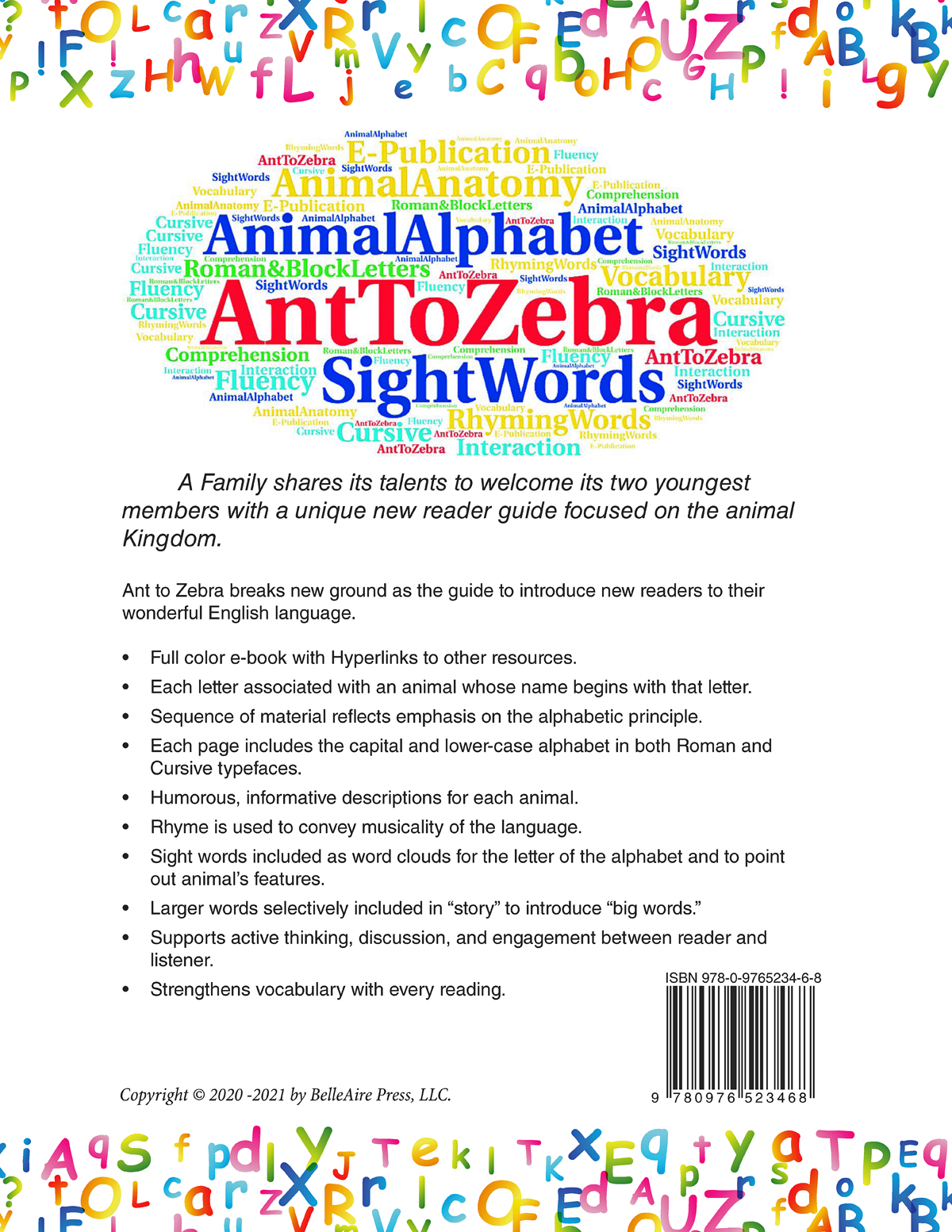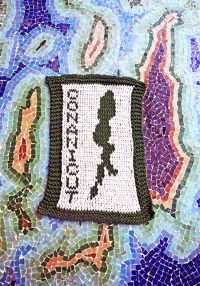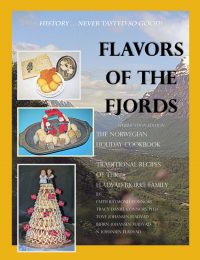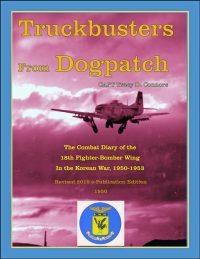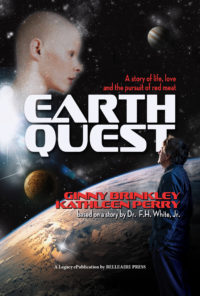Ant to Zebra: the Enriched (Printable) Introduction to a Child’s A, B, Z’s
$1.99
Ant to Zebra is the new learn-to-read book that combines text, typography, imagery, and sight word clouds to create a new, richer and more nuanced approach to introducing new readers to the fundamentals of learning to read.
A2Z is an Online Printable, a digital download publication that is inexpensive, accessible, and can be customized to meet your needs.
Learning to read is arguably the most important and critical accomplishment of anyone’s childhood. Reading opens up a new world of learning, exploration, and the potential for virtually endless and boundless personal growth.
There is general agreement that in order to be effective, any product or program that seeks to improve reading skills should include elements that stress five important areas of literacy, including: phonological awareness, alphabetic principle, phonemic awareness, sight words, decoding, fluency, and vocabulary.
Ant to Zebra is designed, written, and illustrated to create an enriched approach to introducing new readers to all these important concepts.
Here are some highlights:
- Full color e-book with Hyperlinks to other resources.
- Sequence of material reflects emphasis on the alphabetic principle.
- Each page…
- Presents an interesting animal whose name begins with that letter.
- Includes a description of the animal that emphasizes rhyme, even as it offers factual information about that animal.
- Features an original drawing of that animal with text to convey basic information as sight words about that creature.
- Includes the capital and lower-case alphabet in both Roman and Cursive typefaces.
- Uses humorous, informative descriptions for each animal to provide information and interest.
- Sight words beginning with the highlighted letter are shown in a word cloud – this helps the new reader associate letters with sounds, emphasizes that words are composed of the sounds, and improves vocabulary.
- Ant to Zebra includes over 350 new and useful sight words to help jump start a broad and usefull vocabulary.
- Active thinking and discussions by both reader and listener are encouraged.
- Rhyming tones convey musicality of the language.
- Unique combination of elements in Ant to Zebra contribute to improved comprehension.
- “Big Words” are selectively and appropriately introduced and included to familiarize new readers with the concept of multisyllabic words and how they are composed of morphemes that can be parsed/analyzed into logical components.
- Sight words beginning with the subject letter are included in word clouds to encourage and suggest reading and discussion by the reader to the listener that helps improve early vocabulary.
- The new reader’s vocabulary is broadened by the enriched content and inclusion of material not typically found in “cartoony” children’s books.
Out of stock
Description
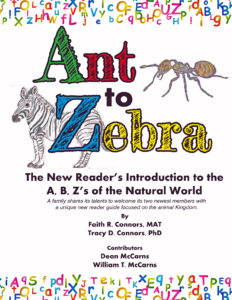
Ant to Zebra is the new, learn-to-read book that combines text, typography, imagery, and sight word clouds. A2Z creates a richer, more nuanced approach to introducing new readers to learning to read fundamentals. A2Z is an Online Printable, a digital download publication that is inexpensive, accessible, and can be customized to meet your needs.
Learning to read is arguably the most important and critical accomplishment of anyone’s childhood. Reading opens up a new world of learning, exploration, and the potential for endless and boundless personal growth.
Many approaches to teaching reading have been offered, and they vary greatly in many cases. Often, ideology seemed as important as research-based approaches. However, there is general agreement that to be effective, any approach seeking to improve reading skills should stress five important areas of literacy, including: phonemic awareness, phonics, fluency, vocabulary, and text comprehension.
Ant to Zebra has been designed and written to create an enriched approach to introducing new readers to these important concepts.
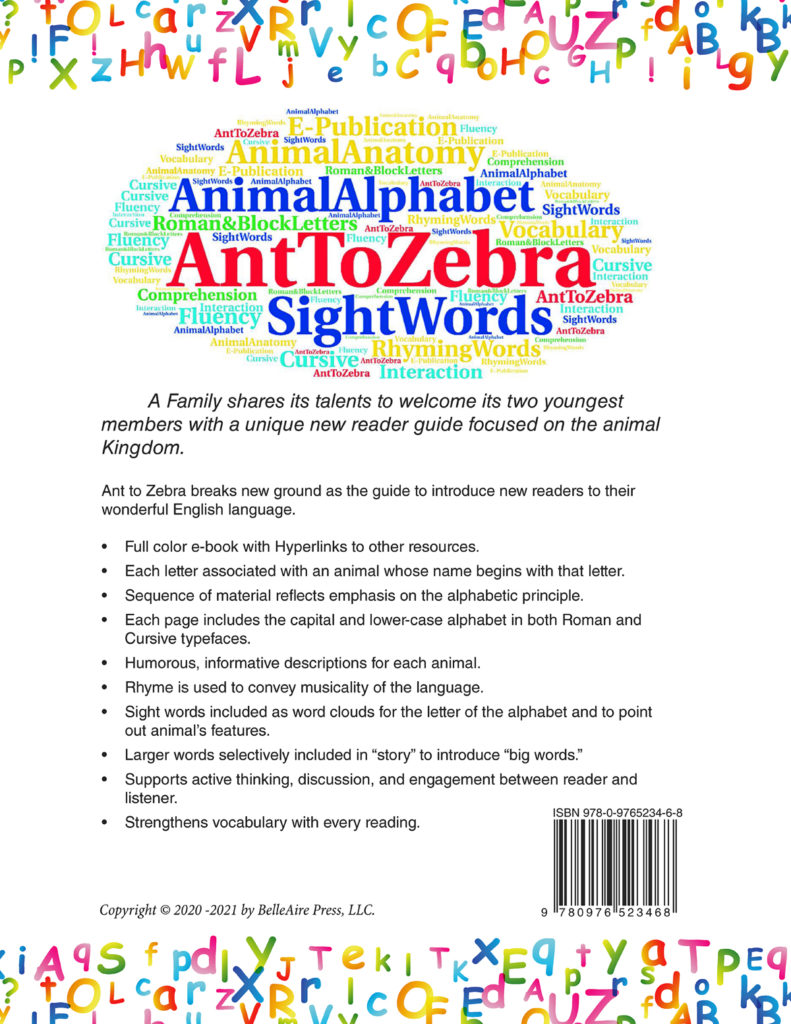
A phoneme in your future.
A critical early competency for all early readers is the “development of phoneme awareness skills.” This means the listeners are able to hear, differentiate, identify, and reassemble phonemes. These are the smallest units of sound that together make up distinct units of meaning (morphemes). For example, the spoken word “cat” includes three distinct phonemes – “c”, “a”, and “t”.
New readers must recognize their alphabet, but to associate that alphabet with specific sounds, which together have meaning. They also need to be able to connect how words sound, to how the sounds are represented by letters.
Ant to Zebra highlights these elements as it presents each animal. It conveys the message to the beginning reader that:
- print carries meaning; and,
- letters can be combined to make words that symbolize things in our life, things that we experience, and things that we think.
Basic reading skills – e.g., phonemic awareness, decoding, and vocabulary – will not likely change significantly in the near future without significant breakthroughs in neural science. However, even as we do our best to strengthen the basics, we can also incorporate new resources into the delivery medium.
Medium
The book was designed from the outset as an e-publication.
The e-publication, digital medium offers many new options as a platform to help new readers acquire basic skills. For example, we envision the most likely presentation medium will be on the iPad. This will allow not only full-page presentations, but do so in full color and with interactive potentials. Not only can letters and words be highlighted, they can be hyperlinked to other trustworthy resources on the web. This enables parents/readers to instantly link to additional sources of information or learning. For example, in Ant to Zebra links are offered to additional Wikipedia information for every animal. Further, many of the animals make sounds that have web-based reproduction links.
Page Layout
Letters are highlighted in both block letters and cursive.
Each page includes a frieze of letters of the alphabet, with not only Roman capitals or block letters shown, but adjacent to them the same letter in cursive or script. This is designed to familiarize the young reader by association from the outset with both capitals and lower case. Cursive (written with letters joined and flowing together into words), does not see the emphasis in today’s public schools that it did in previous years. Private schools, however, emphasize cursive because it is very functional, intended to be used in everyday writing, and allows the communicator to write faster because the letters are connected.
The page layout is the standard 8 1/2 by 11-inch formatted template, making it easier to read on a convenient iPad.
Each page includes:
- the letter being highlighted (both block and cursive);
- a corresponding animal whose name begins with that letter;
- a description of the animal that emphasizes rhyme, even as it offers factual information about that animal; and,
- each page offers an original drawing of that animal and prose to convey basic morphological information about that creature.
Description
Each letter is associated with an animal.
In most cases an animal that is or soon will be known to them, e.g., cat, dog, squirrel. However, not all letters have animals that are likely to be familiar to young children, or even us, for that matter. Therefore, exceptions had to be made for letters and animals such as kangaroo, x-ray tetras, and the yaks.
Descriptions tell something about the animal.
Each animal’s description includes several bits of information about that animal that represent its most noteworthy or widely known characteristics. The descriptions incorporate facts about the animal relating to their habitat, behavior, the sound they make, or their body shape.
Sight words beginning with the highlighted letter are shown in a word cloud – associates letters with sounds, emphasizes that words are composed of the sounds, and improves vocabulary.
The descriptions of the animals are designed to help the beginning reader make sense of the words they are seeing in print, and to understand what they mean. The emphasis on nearby sight words beginning with that letter improves their expanding vocabulary. It also helps build understanding that letters represent sounds, and that words are composed of these separate sounds (phonemes).
Active thinking and discussions by both reader and listener are encouraged.
The descriptions for each animal are lighthearted in tone. They also convey fundamental facts about each animal that enhance comprehension and encourage these new readers to think actively as they read. These descriptions, and the accompanying sight words, encourage the reading adults to fight off boredom, and to stay engaged with the new reader. They can also use their own experiences and knowledge of the world to help the listener make sense of the text and their world.
Rhyming tones convey musicality of the language.
The descriptions also include rhyming words. However, these should not be considered as attempts to create poetry. The terms where appropriate, include simple AB-AB rhyme schemes. The emphasis has been on simple, easily understood terms that convey several bits of information about that animal. Meter, stanza, rhyme scheme were not attempted since the objective is to introduce the young reader to the sounds of language, and hint at its music by using alliteration or gently rhyming words.
The descriptions are written concisely with some emphasis on rhyming. However, adherence to standardized rhyme schemes – AABB – is subordinated to clarity in conveying the information about that animal. Rhyme schemes are important to convey the musicality of our language, but if we torture the words or syntax in favor of the rhyme over the meaning, we weaken the facts and suggest syntax not used in typical speech.
Phonemes and Morphemes
Ant to Zebra uses gentle rhymes and rhythms as phonemes (distinct units of sound, e.g., p, d, b, that distinguish one word from another), and morphemes (a word or part of a word that has meaning) to help the new reader distinguish one word from another in the English language.
Presentation of material reflects emphasis on the alphabetic principle.
A child’s reading development depends on whether or not they understand the alphabetic principle – the concept that letters and patterns of letters represent a word with meaning (the concept of decoding), and the way that word sounds when it is spoken in English (phonics).
Listening to the reader sounding a text accurately, quickly, and with various expressions, conveys the concept of fluency to the new reader – the ability to speak or write the language accurately and easily. It signals that “if I can, you can,” to the new reader.
Discussions of the animals, their descriptions, and the accompanying sight words, helps strengthen the foundations of writing development which will parallel the learner’s development as a new reader.
Comprehension
Unique combination of elements in Ant to Zebra contribute to improved comprehension.
As new readers learn to put letters together to make words, and to recognize them, their comprehension is expanded accordingly. The more they read and the more they are read to, following along with the adult reading slowly and enthusiastically. The easier it is for young readers to understand characters, settings, and plots. Even in our concise explanations of each letter and word, we have emphasized the presentation so that it will help new readers put letters together to make words.
Larger Words
“Big Words” are selectively and appropriately introduced and included to familiarize new readers with the concept of multisyllabic words and how they are composed of morphemes that can be parsed/analyzed into logical components.
Young readers tend to follow or even imitate what they hear the adults around them using for language. We can use that to our advantage by introducing them to a larger vocabulary, including “big words.” Used in the right context, big, multisyllabic words help expand the new readers vocabulary. They also help them become better readers because they have been exposed to differing combinations of sounds in a variety of different words. We have attempted to include such words, including some scientific terms, to introduce them to the sounds, and to imply some meaning based on the context in which they’re used. It also gives the adult opportunity to interact with the new reader who might question the word, thus enabling the adult to explain it in their own terms.
Fluency
Sight words beginning with the subject letter are included in word clouds to encourage and suggest reading and discussion by the reader to the listener that helps improve early vocabulary.
Sight words are those words that young readers are encouraged to memorize as a whole by sight so that they can automatically recognize them without having to use time or energy to actually decode them into their actual letters or syllables. Ant to Zebra points out sight words that are frequently found in common speech and books that begin with that particular letter, and suggest them to the reader as a way to help the young listener memorize them.
Vocabulary
The new reader’s vocabulary is broadened by the enriched content and inclusion of material not typically found in “cartoony” children’s books.
Ant to Zebra keeps in mind that new readers are increasing their vocabulary every time they are read to or they read it for themselves. Seeing the same words in the same context enables them to recognize words by sight.
Finally, the description of each animal keeps in mind that the actual reader will be older than the listener. We have attempted to keep the descriptions lighthearted, and where appropriate, humorous in the hope that it would keep the actual reader/parent interested and engaged in the process.
Also, the word cloud of sight words allows the reader to point out, describe, and pronounce these important words to the listener.
Other interesting reads by BelleAire Press include: Flavors of the Fjords, Love Midgie, Rhode53Island, and Baited Trap.
